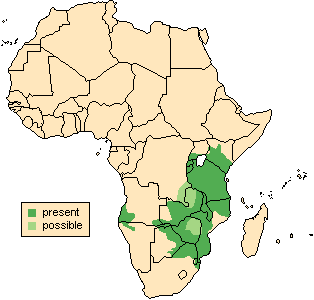![]() Return
to Artiodactyla
Return
to Artiodactyla
Classification
|
 Aepyceros
melampus
Aepyceros
melampus
Impala
![]()
Taxonomy
 |
 |
 |
Click on the pictures above for a larger view of the
photographs
|
||
General Characteristics
Body Length: 120-160 cm / 4-5.3 ft.
Shoulder Height: 75-95 cm / 2.5-3.1 ft.
Tail Length: 30-45 cm / 12-18 in.
Weight: 40-80 kg / 88-176 lb.The short, glossy coat has a reddish saddle over a light tan torso. The undersides are white, as are the rings around the eyes. The muzzle and chin are lighter in colour. There are black markings on the ear tips and three black stripes on the rump: two on the flanks and one down the tail. There are tufts of dark hair above the rear hoofs which give the impala its specific name. The lyre-shaped horns, found only in males, are "S"-shaped and slender. With strong ridges, they grow 45-92 cm / 18-37 inches long.
Ontogeny and Reproduction
Gestation Period: 6.5-7 months.
Young per Birth: 1
Weaning: After 4-6 months.
Sexual Maturity: Females at 1 year, males at 1.5 years.
Life span: Up to 15 years.Two birthing peaks occur - one in spring and one in autumn. After birth, kids lie concealed away from their mother, subsequently joining a 'kindergarten' group with other animals of the same age.
Ecology and Behavior
The impala is active throughout the 24-hour day, alternating resting and grazing, and drinking at least once a day. Herds have a home range of about 2-6 square kilometers. About 1/3 of adult males hold territories, which vary in size from 0.2-0.9 square kilometers. These territories are marked with urine and feces, and are defended against the intrusion of rival males. The owner of the territory attempts to control any female herds which wander into it. Prodigious leaps are the most well known feature of the impala's movement. Executed seemingly without effort, these jumps may span over 9 meters / 30 feet and may be 2.5 meters / 8 feet high - often over bushes and even other impala. Unlike many other plains grazers, the impala flees into dense vegetation rather than out into the open grassland. During the breeding season, males make a hoarse grunting sound.Family group: Males in herds of about 30, females and young in herds of up to 200.
Diet: Grasses, leaves, blossoms, fruit.
Main Predators: Lion, leopard, Cape hunting dog, spotted hyena, crocodile, python.
Distribution
Wooded savannahs in eastern Africa, and an isolated pocket in Namibia.

Range Map (Redrawn from IEA, 1998)
Conservation Status
The impala is classified as a low risk, conservation dependent species by the IUCN (1996). The black-faced impala, A. m. petersi, is classified as a vulnerable subspecies.
Remarks
Impala is a Zulu name. Aipos (Greek) high, lofty; keras (Greek) the horn of an animal: referring to the long, lyre-shaped horns of the male. Melas (Greek) black; pous (Greek) the foot: hence melampus (Greek) black-footed, an allusion to the black tuft of hair covering a gland on the heel of the hind legs.
Literature Cited
IEA (Institute of Applied Ecology) 1998. Aepyceros melampus. In African Mammals Databank - A Databank for the Conservation and Management of the African Mammals Vol 1 and 2. Bruxelles: European Commission Directorate. Available online at http://gorilla.bio.uniroma1.it/amd/amd148b.htmlNowak, R. M. [editor]. 1991. Walker's Mammals of the World (Fifth Edition). Baltimore: The Johns Hopkins University Press.
Walther, F. R. 1990. Reedbucks, waterbucks,.and impalas. In Grzimek's Encyclopedia of Mammals. Edited by S. P. Parker. New York: McGraw-Hill. Volume 5, pp. 448-461.
Wilson, D. E., and D. M. Reeder [editors]. 1993. Mammal Species of the World (Second Edition). Washington: Smithsonian Institution Press. Available online at http://nmnhwww.si.edu/msw/
Return to Artiodactyla

![]()
© Brent Huffman, www.ultimateungulate.com |
|
|